Speaker
Description
The physics reach and feasibility of the Future Circular Collider (FCC) with centre of mass energies up to 100\,TeV and unprecedented luminosity have been studied and published in a Conceptual Design Report (CERN-ACC-2018-0058). The new energy regime of the FCC-hh opens the opportunity for the discovery of physics beyond the standard model.
In order to exploit the full physics potential of such a collider, a conceptual design of a possible reference detector has been developed. Proton-proton collisions at 100\,TeV will produce very high energetic particle showers in the calorimeters from both, light jets and boosted bosons and top quarks. The reconstruction of such objects sets the calorimeter performance requirements in terms of shower containment, energy resolution and granularity. Furthermore, high-precision measurements of photons and electrons over a wide energy range are crucial to fully exploit the FCC-hh physics potential, especially given the large amount of collisions per bunch crossing the detectors will have to face (pile-up of up to $\left<\mu\right>= 1000$).
This talk, on behalf of the FCC-hh detector group, will give a more detailed description of the design considerations. The benchmark physics channels used in the design will be introduced and a detailed description of the detector conceptual choices in terms of technology, geometry, granularity etc... will be given.
